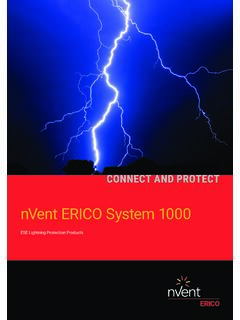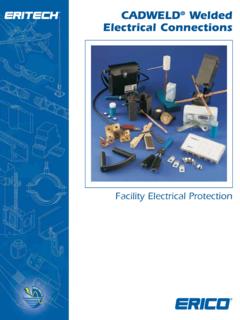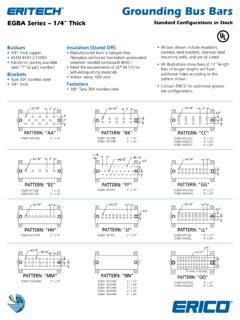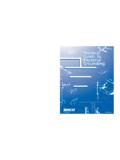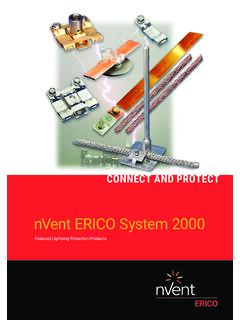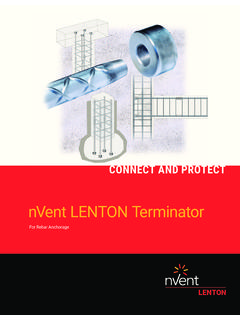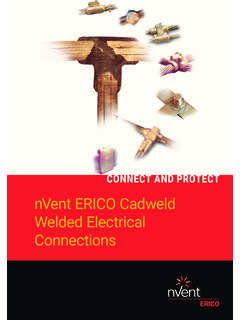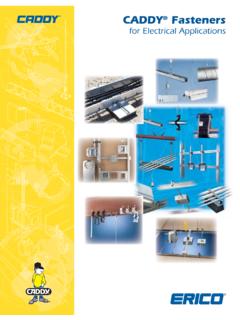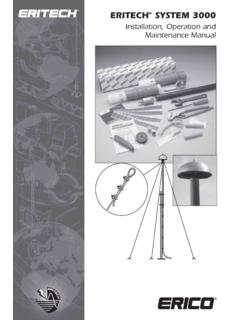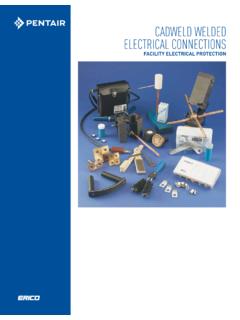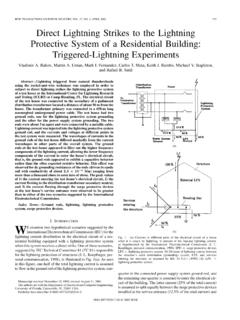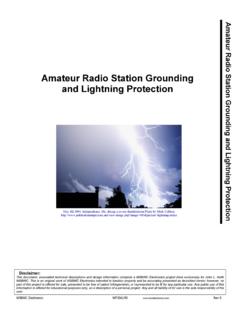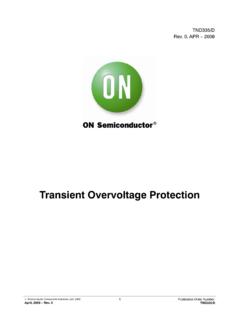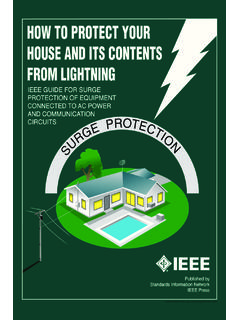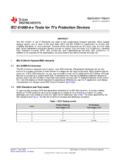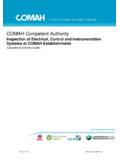Transcription of ERICO LIGHTNING PROTECTION HANDBOOK
1 ERICO LIGHTNING . PROTECTION HANDBOOK . DESIGNING TO THE IEC 62305 SERIES OF LIGHTNING . PROTECTION STANDARDS. LIGHTNING PROTECTION Consultant HANDBOOK Pentair Engineered Electrical & Fastening Solutions is a leading global manufacturer and marketer of superior engineered products for niche electrical, mechanical and concrete applications. These Pentair products are sold globally under a variety of market-leading brands: ERICO welded electrical connections, facility electrical PROTECTION , and rail and industrial products; CADDY fixing, fastening and support products; ERIFLEX low voltage power and grounding connections; and LENTON engineered systems for concrete reinforcement. For more information on ERICO , CADDY, ERIFLEX and LENTON, please visit Introduction This HANDBOOK is written to assist in the understanding of the IEC 62305 series of LIGHTNING PROTECTION standards.
2 This guide simplifies and summarizes the key points of the standards for typical structures, and as such, the full standards should be referred to for final verification. This HANDBOOK does not document all IEC requirements, especially those applicable to less common or high risk structures such as those with thatched roofs or containing explosive materials. In many situations there are multiple methods available to achieve the same end result; this document offers Pentair's interpretation of the standards and our recommended approach. In order to provide practical advice, information is included on industry accepted practices and from other standards. NOTES: IEC and national standards continue to evolve.
3 This HANDBOOK was written with reference to the current editions of these standards as of 2009. Due to regional variations, the terms earthing and grounding may be used interchangeably. WARNING. Pentair products shall be installed and used only as indicated in Pentair's product instruction sheets and training materials. Instruction sheets are available at and from your Pentair customer service representative. Improper installation, misuse, misapplication or other failure to completely follow Pentair's instructions and warnings may cause product malfunction, property damage, serious bodily injury and death and/or void your warranty. 2. Key Terms and Abbreviations Term Definition Part of the LIGHTNING PROTECTION system to intercept the LIGHTNING flash (strike).
4 For example, Air-Termination an air-terminal providing a PROTECTION angle to protected equipment, or horizontal or vertical conductor providing PROTECTION via the mesh method British Standards (BS) Body responsible for implementation of national British standards, identified by BS prefix European Committee for Electrotechnical Standardisation (essentially European standard or Norm, CENELEC. identified by EN or NE prefix). Classification of LIGHTNING PROTECTION system. Class I, II, III, IV relate to the LIGHTNING PROTECTION level Class (of LPS). and define, for example, the different rolling sphere diameters to be used Those parts of the earth termination system in direct contact with the earth, such as ground rods, Earth electrodes buried wires, foundation earthing, etc Earth-termination Part of the external LPS to dissipate LIGHTNING current into the earth External LIGHTNING Air-termination(s), down-conductor(s) and earth termination(s).
5 PROTECTION system Internal LIGHTNING Equipotential bonding and/or electrical isolation of the external LPS from internal conductive PROTECTION system elements IEC International Electrotechnical Commission, responsible for formation of International Standards LIGHTNING PROTECTION Number assigned to represent maximum and minimum LIGHTNING parameters that should not be level (LPL) exceeded by natural LIGHTNING LIGHTNING PROTECTION Complete system for LIGHTNING PROTECTION of structure. Includes internal and external LIGHTNING system (LPS) PROTECTION measures LIGHTNING PROTECTION zone Zone where LIGHTNING electromagnetic environment is defined (LPZ). Mesh method (MM) Method to determine position of air-termination system PROTECTION angle method Method to determine position of air-termination system (PAM).
6 Rolling sphere method Method to determine position of air-termination system (RSM). Separation distance Distance between two conductive parts where no dangerous sparking (flashover) can occur Circuits and pipes, etc, entering into structure from external environment. Typically phone, Services power, TV, gas, water, sewerage systems, etc Surge protective device Device for protecting electrical/electronic equipment from transient voltage damage (SPD). 3. Table of Contents 1. IEC and EN Standards 6. IEC 62305 series 6. EN 50164 series 6. Normative and informative 8. IEC terminology 8. 2. Theory of the LIGHTNING flash 9. The thundercloud 10. Mechanics of the LIGHTNING strike 10. LIGHTNING parameters 11.
7 LIGHTNING damage and risk management 13. 3. Introduction to PROTECTION methods and risks 14. Risks 15. 4. Risk management 17. Overview of risk analysis 17. 5. LIGHTNING PROTECTION zones 22. 6. Design process 23. 7. Material requirements 24. Copper versus aluminum 24. Use of dissimilar metals 25. PVC covered and concealed conductors 27. Tape, versus solid round, versus stranded 27. 8. Natural components 28. Metallic facades, profiles, rails, etc 28. Use of steelwork 28. Use of rebar in reinforced concrete 28. 9. Design methods 33. Rolling sphere 35. Mesh method 37. PROTECTION angle method 39. 10. Air-terminations 43. Recommendation on positioning 44. Masts and antennas 45. PROTECTION of other items protruding above the roof 45.
8 Bonding of roof top fixtures 48. Expansion joints and roof penetrations 48. 11. Down-conductors 49. Down-conductors for isolated and non-isolated LPS 50. Down-conductor routing 50. Fixing of down-conductors 51. 4. Table of Contents (continued). 12. Bonding and separation distances 52. Bonding of services and external conductive parts 52. Separation distance requirements 53. Bonding of internal metallic items and other services 54. 13. ERICO Isolated Down-conductor 55. Telecommunications applications 55. Other applications 56. Isolated Down-conductor design 56. 14. Earthing 57. Earthing resistance requirements 57. Type A vertical and horizontal electrodes 58. Type B ring electrode 59.
9 Comparison of Type A and Type B arrangements 60. Foundation earth electrodes 60. Special earthing measures 61. General earthing advice 62. 15. Inspection and testing 66. 16. Special situations 67. Tall buildings 67. 17. Surge protective devices for low-voltage power distribution systems 68. Surge PROTECTION Devices and Transient Voltages 68. General procedure for SPD selection and installation 71. General information and terms 72. SPD requirements for facilities with LIGHTNING PROTECTION system 73. SPD requirements for facilities without LIGHTNING PROTECTION system 77. Secondary SPD requirements 77. Selection and connection configuration for common power distribution system types 79.
10 Other installation requirements 83. High risk situations 86. 18. Surge protective devices for telecommunications and signalling services 87. 19. Other surge protective device applications 88. 20. British Standard BS 6651 and EN/IEC standards 89. BS 6651-1991 compared to BS EN 62305 89. BS EN 62305-2 compared to IEC/EN 62305-2 90. 21. IEC design standard and EN component standard conflicts 91. 5. 1. IEC and EN Standards The specification of a LIGHTNING PROTECTION system should require that the design complies with the IEC 62305 series of design standards and that materials comply with the EN 50164 series of component standards. The International Electrotechnical Commission (IEC) is a body the type and placement of the LIGHTNING PROTECTION system.
